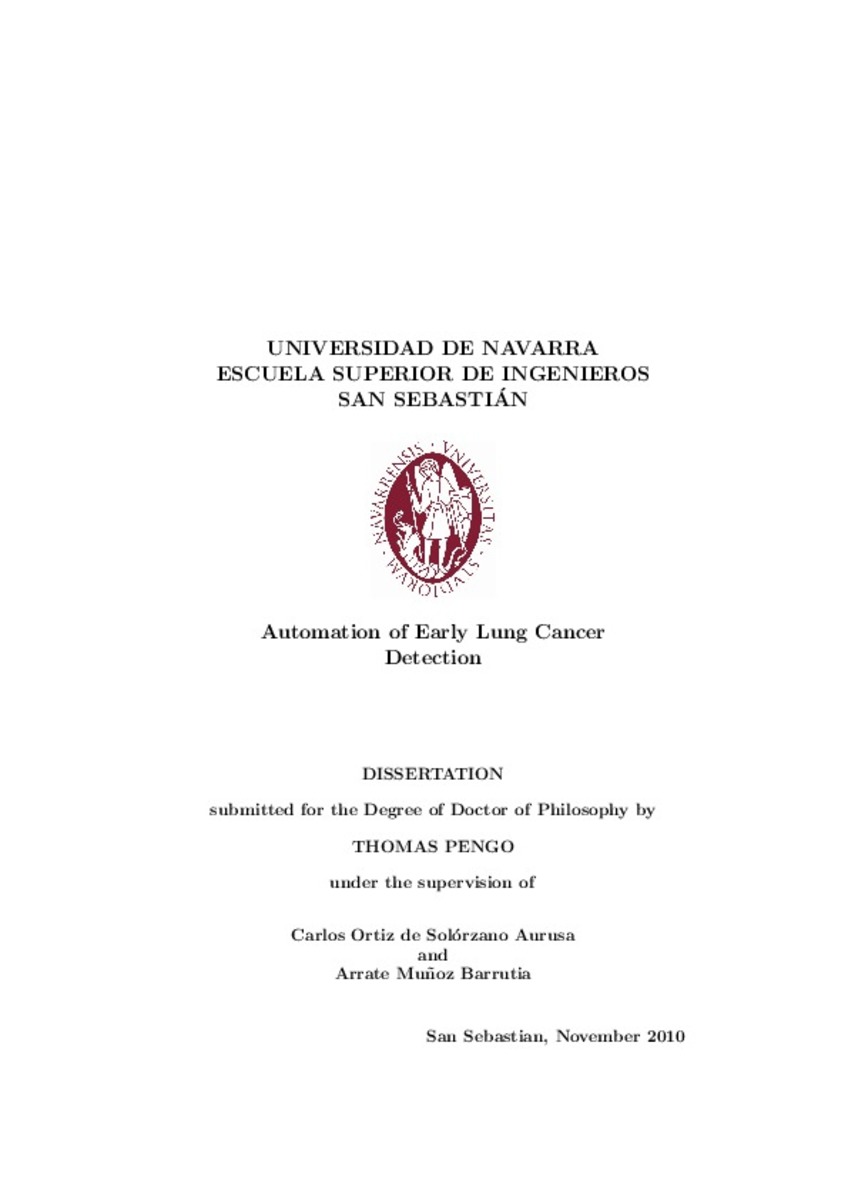Full metadata record
| DC Field | Value | Language |
|---|---|---|
| dc.contributor.advisor | Ortiz-de-Solorzano, C. (Carlos) | - |
| dc.contributor.advisor | Muñoz-Barrutia, A. (Arrate) | - |
| dc.creator | Pengo, T. (Thomas) | - |
| dc.date.accessioned | 2011-01-24T10:24:11Z | - |
| dc.date.available | 2011-01-24T10:24:11Z | - |
| dc.date.issued | 2011 | - |
| dc.date.submitted | 2010-11-08 | - |
| dc.identifier.citation | PENGO, Thomas. ""Automation of early lung cancer detection"".Muñoz Barrutia, A. y Ortiz de Solorzano, C. Tesis doctoral. Universidad de Navarra, 2010 | es_ES |
| dc.identifier.isbn | 84-8081-137-4 | - |
| dc.identifier.uri | https://hdl.handle.net/10171/15640 | - |
| dc.description.abstract | Lung cancer is among the deadliest cancer types, ranking first in mortality rates, with a 15% survival rate over the first five years after diagnosis. The main hurdle in lowering these high mortality rates is that the cancer is often detected too late, when it is already at an advanced stage and only few efective cures exist. There is therefore a great interest in the research community to bring the moment of detection back to the early stages of the cancer. Broncho-alveolar lavage (BAL) is a novel diagnostic technique in which a high pressure liquid is injected in the lungs of the patient using an optical fibre and then successively extracted and analyzed. To analyze BAL samples, we use FICTION, a technique which combines an immunomarker with fluorescence in-situ hybridization (FISH). The analysis of these samples is time consuming and error-prone, as many hours in dificult conditions have to be spent by the pathologist at the fluorescent microscope. The main goal of the project associated with the present dissertation is to automate this process. For this purpose, an automated platform for light microscopy has been developed by integrating a fully automated epi- fluorescent microscope with in-house developed software controlling every stage of the acquisition and the analysis. The platform has been combined with a 2D/3D analysis protocol to isolate candidate cells and, after reconstructing their three-dimensional structure, suggest a diagnosis on a per cell basis. All results at each step of the analysis can be verified for consistency and correctness. The platform and the analysis have been validated on various BAL samples sprinkled with cells from two established cancer cell lines. The platform is believed to have the potential to be applied to other biomedical applications. | es_ES |
| dc.language.iso | eng | es_ES |
| dc.subject | Automation | es_ES |
| dc.subject | Early lung cancer detection | es_ES |
| dc.subject | Computer vision | es_ES |
| dc.subject | Image processing | es_ES |
| dc.title | Automation of early lung cancer detection | es_ES |
| dc.type | info:eu-repo/semantics/doctoralThesis | es_ES |
Files in This Item:
Statistics and impact
Items in Dadun are protected by copyright, with all rights reserved, unless otherwise indicated.






